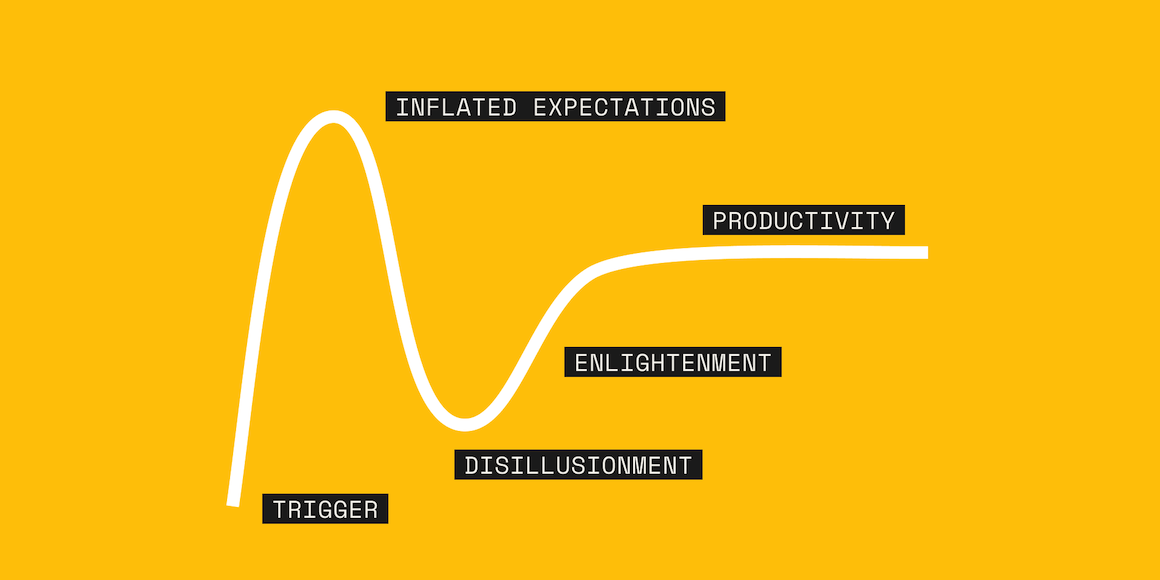
Emerging Technologies: Why You Should Avoid the Shiny Objects
Emerging technologies are the adult equivalent of the proverbial “kid in a candy store”—we can’t get enough of them. But as a business, you can’t afford to be taken in so easily by the newest tools and gadgets. Helping your business succeed is your priority, so avoid shiny objects or exciting new ideas, tools, or goals that distract from current projects.
Orchid Bertelsen, Head of Digital Innovation for Nestle USA, uses the Gartner Hype Cycle to avoid these so-called shiny objects. We caught up with Bertelsen to discuss avoiding shiny objects with this methodology.
The Gartner Hype Cycle
New technology pops up every day, and you need to choose between what’s all talk and what can walk the walk. The Gartner Hype Cycle provides a model for assessing technology’s maturity, evolution, and potential to solve your business problems.
By taking a step back and assessing the latest and greatest from this lens, you can filter out the shiny objects and prioritize the tools that can realistically help you. The Gartner Hype Cycle breaks down into five phases: Innovation Trigger, Peak of Inflated Expectations, Trough of Disillusionment, Slope of Enlightenment, and Plateau of Productivity.
Innovation Trigger
Every advancement is made for a reason. An innovation trigger is a catalyst for interest in new tech. A technological breakthrough that generates press and attention may be enough to pursue an idea further. At this point, no product exists, and an idea’s viability is as-yet untested, but there is a whole world of possibilities to explore.
Peak of Inflated Expectations
At the Peak of Inflated Expectations, emerging technologies are new and exciting, and the possibilities are endless. At least, that’s how creators and early adopters feel. Convincing the masses can be a hurdle, but the rewards are rich.
Example: Telemedicine was the new kid on the block a few years back, and users were uncertain of everything, from its effectiveness to its privacy. But then COVID-19 happened, and the world had to do a rapid about-face because physician offices were closed or prioritizing virus patients. Patients and healthcare professionals embraced this new mode of care, making way for it to continue to grow toward incorporating AI and providing personalized virtual care.
Trough of Disillusionment
On paper (or screen), the Trough of Disillusionment looks like a valley. Businesses reach this phase when the initial hype dies down and challenges surface. For telemedicine, it was accuracy and privacy. To use telehealth services, you share personal information via computers or mobile devices, and there’s only so much your doctor can see and do.
At this point, creators ask questions and think through the solution carefully. For telemedicine, they likely asked a few key questions:
- How will consumers use the tech?
- What is the right platform to use?
- How can we protect privacy?
Orchid suggests that the right time to test emerging technologies is in the Trough of Disillusionment, a phase that takes challenges into account.
Slope of Enlightenment
Having taken concerns into account and solved for them to deploy an exceptional product, tech developers and early adopters overcome any lingering hesitation and start to see the benefits of the innovation during the Slope of Enlightenment.
Early adopters are invaluable because the information they provide can inform planning and any shifts in priorities. Here, tech companies begin to see how their innovation benefits—or fails to benefit—users and the organization, potentially leading to enterprise funding.
Plateau of Productivity
Welcome to the real world! At the Plateau of Productivity, we see mainstream adoption of technology because its benefits outweigh the risks.
Users are finally comfortable with the solution. Once a product has proven its value, it will quickly take off in the market.
Walk, don’t run toward emerging technologies
It’s easy to become enamored by the bright lights of technology and the latest and greatest shiny objects, but tech innovation and introduction are complicated processes. Don’t go wild in your approach to emerging technologies—walk before you run. Looking through the perspective of Gartner’s hype Cycle can help. Get Bertelsen’s perspective in the full episode of Labs Live.
Looking for more great articles? Check out our blog and subscribe today.
Editor’s Note: This post was originally published in June 2020 and has been updated for accuracy and relevance.